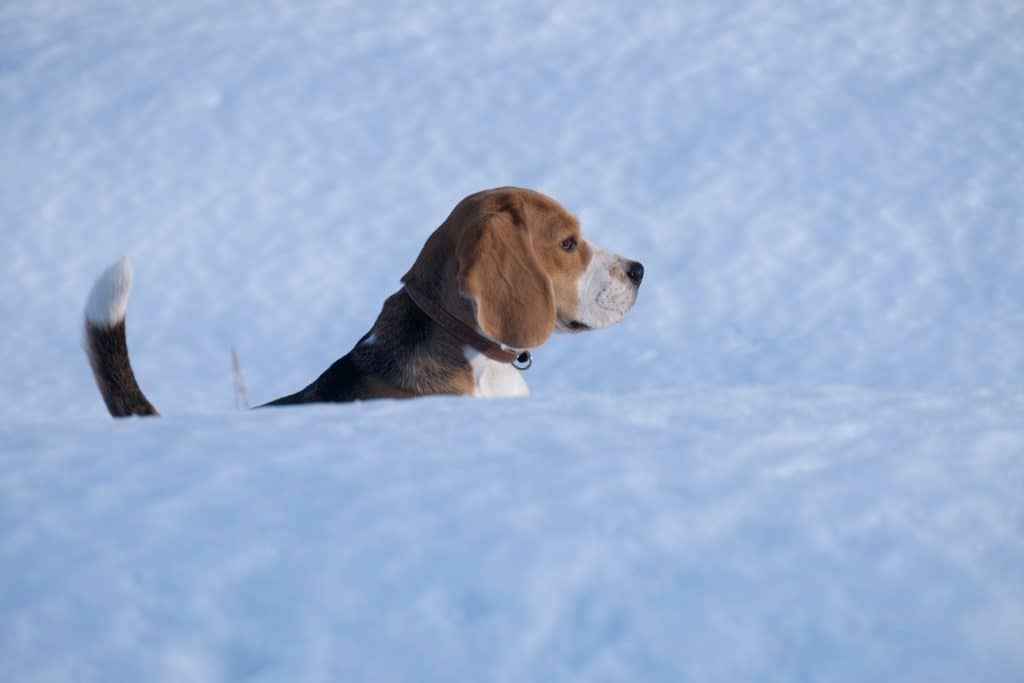Can Beagles Stay Outside in the Cold?

I like beagles, but I happen to live somewhere that gets very cold in the winter. When considering getting one, I first decided to research if beagles can stay outside in the cold.
So, can beagles stay outside in the cold?
Beagles are short-haired and not equipped for harsh or severe weather conditions. If they are left outside in the cold for too long, they can suffer from illness such as frostbite and hypothermia. It’s best for a beagle to be indoors when there is cold weather.
Cold weather can affect beagles in a variety of different ways, but there are also preventative measures that can be taken to protect your dog against the cold.
How Does the Cold Affect a Beagle?
While a short amount of time in the cold may not affect a beagle too much, too long of a stay can lead to harm. One reason for this is that the air is much drier in the cold, and long-term exposure to dry air can start to negatively affect a beagle’s paws, nose, and skin.
A Beagle’s Paws
During the winter, the leather pads on a beagle’s paws can start to dry out due to the lack of humidity in the air. This can potentially lead to cracks and scarring, and overall discomfort for the dog.
Another problem for the paws during the winter is ice melt chemicals or the sand and salt that can be found on many roadways, sidewalks, and other surfaces. These can cause chemical-burn or general aggravation to a beagle’s pads, and so it’s important to be careful when taking your dog out on a walk during the winter.
A Beagle’s Nose
Much like a human’s mouth that can chap during the cold of winter, a beagle’s nose can start to chap as well. If the dog licks its nose, this chapping can increase, which may cause it to lick it even more, in a cycle of discomfort.
A chapped nose will lead to tingling and itching for the dog, and could also possibly lead to cracking on the nose and even infection.
A Beagle’s Skin and Coat
The cold and dry air can also cause issues to a beagle’s skin and coat. It can lead to itchiness as well as thinning coat issues. Also, the static can also cause fur loss due to breakage.
Beagles will also shed more as winter approaches, and it is important to groom your dog and keep its coat healthy in order to prevent infections and to allow its winter coat to come in the correct way.
Beagles have short hair as well, and so when out in the cold, their fur does little to protect their skin and body from being affected much like humans. A beagle can safely stay outside in temperatures below freezing for about 20 minutes.
What are Other Dangers from the Cold?
Besides the physical impact the cold has on beagles, there are a few other things to be aware of as well. Try not to let your dog drink from sources outside, such as gutters or puddles, because these can contain chemicals like antifreeze and oil that will be harmful to a beagle.
Ice can also be an issue, and it’s important to be aware of where it is so that your beagle doesn’t get too close and potentially fall through to freezing water or slide around and hurt itself.
It’s also important to be aware of where your beagle is at all times when outside. Many animals will find shelter in places like car engines or hoods to keep warm. They can also wander off into cellars, snow banks, or hard-to-reach places and become trapped, which can lead to them getting hypothermia or frostbite.
“A typical pet Beagle will be just fine when taken outside to play in the snow and to go for walks, however, he is… able to develop hypothermia and frostbite as much as any other dog that is used to sleeping in a warm house.”
-Beagle Pro-
Frostbite is not always immediately obvious. The dog’s ears, paws, and tail can get cold enough that ice crystals will form in the tissue and damage it. It also pulls blood from your dog’s extremities in an attempt to keep warm.
Hypothermia occurs when the dog’s body temperature gets too low. This can sometimes be mild and lead to weakness, lethargy, or depression. When it gets more severe, muscles start to stiffen, breathing and heart rates slow down, and the dog will stop responding to stimuli.
What Can Be Done to Protect Beagles from the Cold?

There are actually several things that you can do to help protect your beagle from the cold. To protect its paws, you can use canine paw wax to prevent its pads from getting affected by the chemicals or salt.
There are canine nose balms that can be used to help prevent cracking and issues with the leather of your dog’s nose. This should be applied before heading outside and can be used a few times a day to help heal a nose that has been affected by the dry winter air.
For the skin, make sure you don’t decrease baths and in fact, stay on schedule. This is so that it’s fur can stay healthy and moisturized, protecting it from the dry air. A leave-in conditioner can also help defend against static. It’s important to remember the tail and legs as well, as that can often be overlooked.
Another good thing is to make sure your beagle drinks plenty of water. This not only prevents it from drinking the potentially harmful water outside, but it will help keep it healthy and mousturized as protection from the dry air around it.
Some people like to protect their beagles with winter clothing, much like how humans put on more layers and coats. There are special, beagle-sized sweaters and booties that can be worn when you need to take your dog outside on a walk for a little while.
Booties help keep your dog from licking its feet and cracking them, as well as protecting against the chemicals and salt that it could pick up while walking. A sweater can simply serve as an extra layer of warmth and protection for your beagle, and it is also a cute way to accessorize and show off yours and your dog’s personalities during the drab winter months.
Also, it’s important to note that during the winter months, the appetite of a beagle can change. This is because it requires more calories to keep its body warm during this time. It may require up to 15% more food during the winter, but you don’t necessarily have to add a whole other meal.
Adding some fruits or vegetables that are beagle-friendly as a side for its regular meals can work just as well.
If your beagle is very young or is a senior, it may be a good idea to check with a vet before taking it outside during the cold months. This is because their immune systems may be lower, especially with older dogs, and their joints may hurt them more in the cold.
It’s good to be aware of the specific needs of your beagle before spending a lot of time with it out in the cold and snow.
Related Questions:
What temperature can a beagle tolerate?
A beagle will be fine in temperatures that are above freezing, or 32 degrees Fahrenheit. Temperatures below that will start to affect a beagle negatively, and outdoor exposure should be limited, as there will be added stress to their bodies.
How can you tell if a beagle is too cold?
There are several signs to look for, such as whining, shivering, slowing down, or burrowing. Another method is to feel their ears. If the ears feel cold, especially around the edges, it may be a good idea to warm up your dog with a blanket and heat.
Can beagles sleep outside?
In the past, beagles used to be used for hunting, and so were more able to handle staying outside. Nowadays, most beagles are domesticated and therefore will have a harder time staying outdoors, especially with severe weather conditions.
